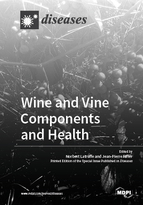Wine and Vine Components and Health
A special issue of Diseases (ISSN 2079-9721).
Deadline for manuscript submissions: closed (30 October 2018) | Viewed by 63618
Special Issue Editors
Interests: bio-active polyphenols; resveratrol; inflammation; bio-availability; cancer; pathologies prevention
Special Issues, Collections and Topics in MDPI journals
Interests: wine and health; cardiovascular protection; wine polyphenols; Mediterranean nutrition and health
Jean-Pierre Rifler is emergency physician at the Haute Côte d’Or hospital center, F-21350, France. He become passioned of wine. After his obtained a diploma of Oenolog technician in 1988, he prepared his medical doctor thesis in 1994 on wine and health, especially on the cardiovascular protection by the red wine polyphenols. Since this date, in parallel to his professional activities, he collaborates with scientists in Burgundy in the aim to promote the beneficial effects of a regular and moderated consumption of wine. He managed thesis of medical doctors and set-up clinical protocols to validate the secondary prevention for post-infarcted patients by wine in 2012. This important work has been published in collaboration with Pr Norbert Latruffe, co-guest editor of this present issue, as follow «A moderate red wine intake improves blood lipid parameters and erythrocytes membrane fluidity in post myocardial infarct patients’’ by Rifler JP., et al., Molecular Nutrition and Food Research 2011. vol. 55 pp1-7». Dr Jean-Pierre Rifler also published numerous specialized papers and his periodically invited in congresses and organizations such as in WAC (Wine Active Compounds), Beaune 2011; or at 5è ICPH (International conference on polyphenols on health), Sitges (Barcelona), 2011. He is co-funder of the Mediterranean Nutrition and Health association which organized a colloquium in Hyères (Provence) in 2016 on Wine, Mediterranean Nutrition and Health. By the way Dr Jean-Pierre Rifler is well known for having initiated the french programme on heart defribrillators in public space to save lifes.
Special Issue Information
Dear Colleagues,
While there is a tremendous literature on the topic of wine and health ranging back to the days of Hippocrates, it is considered that there is an unlimited variety of wine, allowing the association of senses, nutrition, and hedonism. The history of vine and wine has lasted for at least 7000 years. Vitis, an adaptable plant, thanks to a large variety of strains; wine is an alchemie with unique properties; a rich and original composition in terms of polyphenols, and well known anti-oxidants. This explains why wine and health are closely linked to nutrition.
In terms of biochemical mechanisms, vine like other plants produce numerous non-energy compounds, called secondary metabolites (e.g., flavonoids, polyphenols), in order to adapt their defenses against often unfavorable environment (biotic and non-biotic stresses), Interestingly, in humans and in the animals kingdom these microconstituents provide similar valuable bioactive properties for essential cell and physiological function (signaling, gene regulation, prevention of acquired or infectious disease, etc). These compounds have been selected through evolution and are generally preserved in all living beings. For instance, resveratrol that plays an essential role in vine plants as elicitor of the natural defenses has been shown to be a protector of health in humans. It could delay, or even block, the appearance of predominant diseases such as atherosclerosis by protecting low-density lipoproteins from the oxidation, but also diabetes and cancer.
Grape, fresh or dried, is a widely consumed fruit by large human populations, as also its by-products, like grape juice and wine, even extracts of vine leaves and shoot use. They contain vast and highly varied quantities of polyphenols as protective micronutrient. Wine, provide unique polyphenols: for instance, resveratrol, procyanidines and monophenols such as hydroxytyrosol and tyrosol. The research supports the idea that wine, a natural biological product, if consumed regularly, but without excess, possesses preventive properties, not only its well-known properties against vascular diseases (illustrated by the so-called French paradox) but also may prevent infections, decrease inflammation, delay neurodegenerative diseases. The question about cancer is still open.
Despite the huge amount of data on this topic, there is still gray areas and uncomplete knowledge. This is why the objective of this issue is to bring wine to a better view especially through the policy makers, the medical world and the vectors of image in order to explain the rational and the philosophy with respect to ethics and the public health.
The focus of this special issue on wine and vine components and health of the journal “Diseases” will includes the effects of wine on human physiology (cardiovascular, aged-linked disorders and s.o.); the effects of polyphenols as wine anti-oxidants and as signaling molecules; and from a humanity point of view, the tasting properties of wine.
Manuscripts (primary articles or review) providing new data and new concepts related to the following keys words are welcome: i.e. wine, vine and grape components including vitamins, minerals, ethanol and polyphenols such as resveratrol, and flavonoids; their bio-availability and metabolism; their effect on pathologies such as aging, longevity, cardiovascular, diabetes, cancer, obesity, inflammation, neurodegenerescence, cognition loss, pain, infection, skin problems, altered physical activity and s.o.
Prof. Dr. Norbert Latruffe
Dr. Jean-Pierre Rifler
Guest Editors
Manuscript Submission Information
Manuscripts should be submitted online at www.mdpi.com by registering and logging in to this website. Once you are registered, click here to go to the submission form. Manuscripts can be submitted until the deadline. All submissions that pass pre-check are peer-reviewed. Accepted papers will be published continuously in the journal (as soon as accepted) and will be listed together on the special issue website. Research articles, review articles as well as short communications are invited. For planned papers, a title and short abstract (about 100 words) can be sent to the Editorial Office for announcement on this website.
Submitted manuscripts should not have been published previously, nor be under consideration for publication elsewhere (except conference proceedings papers). All manuscripts are thoroughly refereed through a single-blind peer-review process. A guide for authors and other relevant information for submission of manuscripts is available on the Instructions for Authors page. Diseases is an international peer-reviewed open access monthly journal published by MDPI.
Please visit the Instructions for Authors page before submitting a manuscript. The Article Processing Charge (APC) for publication in this open access journal is 1800 CHF (Swiss Francs). Submitted papers should be well formatted and use good English. Authors may use MDPI's English editing service prior to publication or during author revisions.
Keywords
- wine
- vine and grape components
- vitamins
- minerals
- ethanol
- polyphenols
- resveratrol
- flavonoids
- bio-availability
- metabolism
- hathologies
- aging
- longevity
- cardiovascular
- diatetes
- cancer
- obesity
- inflammation
- neurodegenerescence
- cognition loss
- pain
- infection
- skin problems
- altered physical activity







